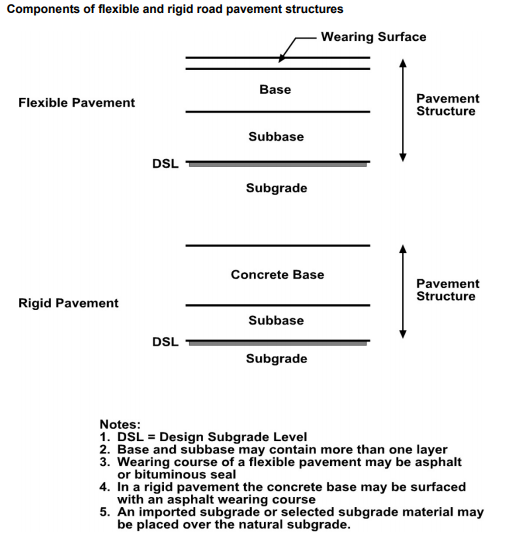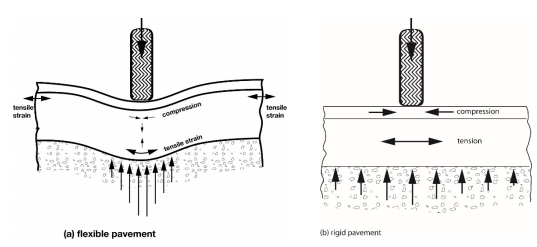Purpose of Pavements
The contribution of a road pavement to the overall road formation is shown in Figure 2.1. The pavement must serve two basic functions, it must perform as an engineering structure and at the same time meet functional requirements. In terms of structural performance, the pavement must be of sufficient thickness, and be composed of materials of sufficient quality, to be able to withstand the various loads that are applied to it by heavy vehicles. In terms of functional performance, the pavement must have a good riding quality to ensure comfortable travel for the road user and, in the case of surfaced pavements, a surface having adequate drainage, skid resistance, reflectivity and line markings to ensure safe travel. The surface must also be capable of resisting both vertical and horizontal surface stresses to maintain its integrity. If the surface is lost, or cracked, then ride comfort is affected and water can enter the underlying base layers. It must also be capable of withstanding environmental loads, including oxidation of bituminous binders. Inherent in these demands is the need to ensure that construction and maintenance practices are adequate for the demand to be placed upon the pavement. Australia has about 800,000 km of roads, of which about two-thirds are unsealed (Austroads 2000).
Pavement Types
Pavements are classified as either flexible (containing unbound granular and/or stabilised materials and/or asphalt) or rigid (concrete pavement with joints and/or steel reinforcement). The term “flexible pavement” is applied to all pavement structures other than those described as rigid pavements, including unbound pavements with thin bituminous surfacing, and bound (stabilised and asphalt) pavements. They are designed and generally constructed as continua, without formal joints. The most common sealed flexible pavement used in Australasia is the unbound granular pavement with a thin bituminous seal. Their design is empirically based. The design of pavements incorporating a bound layer, or full depth asphalt pavement, is mechanistic using elastic layer modelling. This relies on the stiffness (modulus) properties of continuous layers, in a macro sense appropriate to potentially cracked media, rather than material properties measured in the laboratory. A rigid pavement consists of a relatively high strength concrete base (usually 30 MPa or more) and one of a range of subbase materials (lean mix concrete, cement stabilised crushed rock, unbound granular material, etc.). The various concrete base formats are jointed unreinforced (plain concrete), jointed reinforced, continuously reinforced, and steel fibre reinforced. With the exception, perhaps, of roller compacted concrete, rigid pavements have formal jointing systems that are sealed against moisture. In the case of continuously reinforced

concrete pavements, there are longitudinal joints, but no regular transverse joints for shrinkage and thermal strains. The thickness design method for rigid pavements takes into account the presence of joints and edges. Flexible pavements can be constructed in stages (staged construction) and, in many cases, repair of underground services is simpler than for rigid pavements. There are advantages and disadvantages associated with each pavement type. These need to be considered along with construction constraints, material availability and costs, and the need to optimise the costs of the overall pavement system.
The generic components of flexible and rigid road pavement structures are shown in Figure 1. A brief description of each component follows.
Wearing Surface
The primary function of the surface course is to withstand the prevailing loading and environmental (moisture, dust, etc.) effects and hence provide a safe and functional riding surface with reduced spray and noise while at the same time protecting the underlying pavement courses from moisture ingress. The three types of surface courses most commonly used on roads in Australasia are sprayed (or chip) seals, asphalt and concrete. Interlocking concrete pavers have only very limited application in high-speed traffic situations and their use is limited to urban applications. The sprayed bituminous seal (or chip seal) was developed in New Zealand in the 1930s (Hanson 1935). It provides an economical solution to the surfacing problem. It consists of a thin film of bitumen sprayed on top of a compacted base and incorporates a layer of single-sized stone. In the majority of cases, they are used as a surface over an unbound granular base. They are a low-cost alternative to other forms of sealed pavements such as asphalt. Whilst spray seal surfacing mainly contribute to the functional performance of a pavements (i.e., provide a safe, all-weather driving surface), asphalt and concrete also have roles to play in terms of the structural performance of the pavement. Thin (30-50 mm) asphalt surfacing play a role in delivering functional performance whilst thicker, including full depth asphalt, also deliver structural capacity.
Base
The base is the main load carrying course within the pavement. An unbound basecourse is composed of materials which are granular or mechanically stabilised or treated with binders to improve properties other than strength (e.g., plasticity). An unbound basecourse therefore behaves under load as if its component parts were not bound together although significant mechanical interlock can occur. In most cases an unbound granular basecourse is provided under a sprayed seal surfacing. The quality of the base can be improved using stabilisation; the most common stabiliser used with unbound granular materials is cement. In rural applications a sprayed seal surfacing is generally applied over the stabilised base. In terms of rigid pavements, the thickness of the concrete base will vary according to the type of shoulder and joint/reinforcement details adopted. The selection of the overall pavement configuration is a matter for decision by the designer based on its suitability for a particular project and economic considerations.
Subbase
The subbase in a flexible pavement is also a load carrying course; its lower quality is related to economics and the lower stress levels than those near the pavement surface. The main role of the subbase is to provide adequate support to the base and reduce the stress/strains applied to the subgrade. It may also be used to reduce the pumping of subgrade fines through joints or cracks onto the surface of a pavement following the action of traffic or ground water pressure. The quality of the base can be also improved using stabilisation, including mechanical stabilisation or the use of cement, lime or a bituminous binder. The practice is more common when the parent material is a marginal or non-standard material, often won locally.
In terms of rigid pavements, the provision of a bound or lean mix concrete subbase is recommended to:
- Resist erosion of the subbase and limit pumping at the joints and slab edges
- Provide uniform support under the pavement
- Reduce the magnitude of the deflection at joints and enhance load transfer across joints, especially if no other load transfer devices, such as dowels, are provided
- Assist in the control of shrinkage and swelling of high-volume-change subgrade soils.
Subgrade
The subgrade is the trimmed or prepared portion of the formation on which the pavement is constructed. The subgrade may be the prepared in situ material but, particularly for heavy duty pavements, it may also include selected materials which are placed above the in-situ material. Many factors must be considered in determining the subgrade support conditions, including the consequences of premature distress, sequence of earthworks construction, target compaction moisture content and field density achieved, moisture changes during the life of the pavement, subsurface drainage and depth of the water table and the presence of weaker layers below the design subgrade level. Subgrades are inherently variable in nature, reflecting the changes in topography, soil type and drainage conditions that generally occur along an existing or prepared road alignment. The selection of the appropriate design value for the subgrade requires a consideration of the degree of variability within a project section and the quantity and quality of data on subgrade properties available to the designer. Improved subgrades refer to subgrades that have had their properties improved in order that they can provide sufficient support to the upper layers and withstand the stresses applied to them under load. Other practical considerations include the need to provide adequate access to construction traffic (i.e., a working platform). Improvement can be achieved through stabilisation of the parent material or the introduction of an imported material placed over the parent material. A working platform can be considered either a subbase layer or an improved subgrade layer. For a low formation height road containing few layers, the working platform may comprise a lower subbase layer but, for a high formation, it would generally be described as an improved subgrade with embankment material to be placed over it.
Pavement under load
The basic function of a pavement is to support the applied traffic loading within acceptable limits of riding quality and deterioration over its design life. To do this, the pavement structure must spread the concentrated wheel loads to the foundation (subgrade material) such that, under peak and accumulated (e.g. fatigue) traffic loads:
- The pavement materials and subgrade do not deform excessively
- The pavement courses do not crack excessively.
To achieve these objectives, the pavement structure must be protected from the effects of environment. The first two requirements are addressed using the pavement layer thickness and stiffness to disperse the concentrated surface load to stress levels acceptable for the various materials.

As mentioned earlier, the load-spreading effect of unbound granular materials is essentially through inter-particle friction and shear strength, which depend on the presence of horizontal confining stresses (Figure 2). On the other hand, bound layers tend to spread the load through slab action, as significant horizontal tensile stresses can be sustained at the bottom of the layer. The ability of a material to withstand repeated cycles of vertical stress without excessive deformation being induced is called the “bearing capacity”. As a result, the higher quality, or stiffer, materials were traditionally used in the top layers of the pavement. A contemporary alternative option, however, is the upside down pavement, which consists of a relatively thick and stiff (stabilised) subbase and an unbound granular basecourse. These pavements can be used in situations where shrinkage cracking of a stabilised basecourse layer and the resultant reflection cracking through the surface is an issue. Because a flexible pavement deforms (bends and deflects) under load, horizontal tensile strains are produced (Figure 3). The vertical compressive strains in the pavement and subgrade produce the deformations in unbound layers and asphalt which lead to rutting, whereas the horizontal tensile strains can induce cracking in bound layers. Loading applied to relatively stiff rigid pavements, on the other hand, results in a relatively uniform distribution of strain on the subgrade (Figure 3). The two modes may be used in one application. For example, flexible subbases can be used under concrete bases to provide a drainage layer, absorb subgrade volume changes and provide a working platform though pumping of fines through the joints of a concrete base layer can be a problem for heavily trafficked roads.

